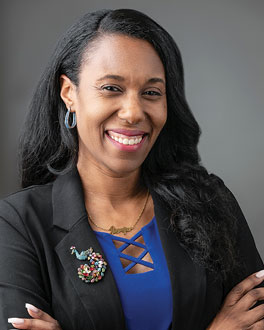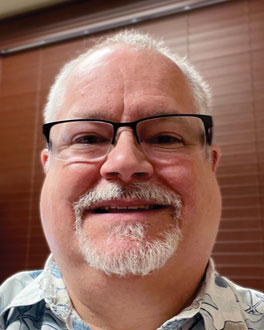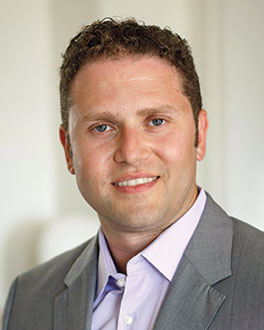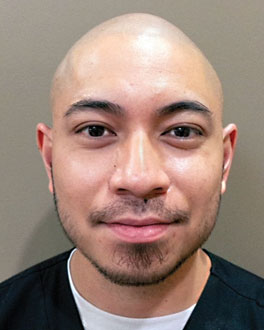During the pandemic, it hasn’t been unusual to see a director of nursing (DON) in the kitchen, human resources staff making beds, maintenance staff picking up or dropping off employees, and administrators feeding patients. There’s an “e” in teamwork, and in the past year, that’s stood for “everyone helps everyone else.”
 As Jennifer Oguin, RN, DON, at Trinity Care Center in Round Rock, Texas, says, “My title went out the window. When it comes down to it, we are a team that pulls together without even asking. People just jump in and do what needs to be done. It’s embedded in our culture.”
As Jennifer Oguin, RN, DON, at Trinity Care Center in Round Rock, Texas, says, “My title went out the window. When it comes down to it, we are a team that pulls together without even asking. People just jump in and do what needs to be done. It’s embedded in our culture.”
Teamwork has taken on new meaning during the pandemic. Facilities have implemented new strategies for communication, collaboration, and innovation. Transparency, resilience, and empathy are not buzzwords but essential elements of daily work life.
Getting past the pandemic and the politics of 2021 calls for renewed efforts to focus on the residents and what it takes to keep everyone safe and engaged, as well as building and strengthening cultures that will weather any storm or crisis.
Head of the Class: Education Moves Up
Team education has always been essential in post-acute and long term care. However, during the pandemic, it’s taken on a new level of urgency. It’s also been more challenging, as guidance, recommendations, and clinical evidence regarding COVID-19 have changed constantly. Keeping up with this has been challenging.
How challenging? Well, according to Ohio State University researchers, there have been more than 87,000 scientific papers alone on the coronavirus since the pandemic started.
“You have to communicate frequently and have one-on-one conversations,” says Oguin. “You have to discredit misinformation before it spreads and is embraced as fact.” At first, she says, people were often confused and frightened.
However, she says, “We have kept staff informed as new evidence and information arises. As they saw positive results from guidance and protocols, it lessened their fears and increased their confidence and trust.”
Keeping everyone on the same page when they are getting different information from several sources is “a constant battle,” Oguin says. “As the CDC [Centers for Disease Control and Prevention] put out new guidance, we were regularly updating protocols and recommendations.”
 When change is this constant, it is important to acknowledge that it’s frustrating and challenging, she says. “You need to say, ‘We’re doing this, too; we’re there with you. We know this is new and different, but it’s the right thing to do.’ You need to have a team that trusts you, and this helps build trust.”
When change is this constant, it is important to acknowledge that it’s frustrating and challenging, she says. “You need to say, ‘We’re doing this, too; we’re there with you. We know this is new and different, but it’s the right thing to do.’ You need to have a team that trusts you, and this helps build trust.”
Jeffreys Barrett, RN, MHA, NHA, executive director of Wellsprings of Gilbert in Arizona, says, “Early on, there were some people who didn’t believe COVID was a real virus, and others who were terrified of it. I would post emails once a week and constantly communicate information we received from the CDC and department of health.”
At some point, he suggests, “You can only educate people until they stop listening. But you can build a level of trust between yourself and others and deal with what is happening without being bombastic or threatening.”
As the pandemic wore on and the holidays approached, team leaders wanted to ensure that staff resisted the urge to attend large parties and family gatherings. “We provided a lot of staff education leading up to the holidays talking about ways to safely celebrate with family and friends,” Barrett says.
Buster Peter, administrator of Park Bend Health Center in Austin, Texas, says, “Then we gave staff take-home kits with PPE [personal protective equipment], hand sanitizer, and other items. We got the most positive response we’ve ever gotten for a staff gift. They appreciated getting something that they needed.”
Hiring for Character
 Hiring during the pandemic was challenging. It was difficult to vet job candidates to determine if they’d be a good fit for the organizational culture. Yet, it’s important to communicate that “if you are devoted to the residents and this patient population, you will do everything possible to protect the resident,” says Steven Buslovich, MD, CMD, MSHCPM, a New York-based geriatrician and chief executive officer of software producer Patient Pattern. “If you’re doing it solely for the paycheck, this isn’t likely the place for you.”
Hiring during the pandemic was challenging. It was difficult to vet job candidates to determine if they’d be a good fit for the organizational culture. Yet, it’s important to communicate that “if you are devoted to the residents and this patient population, you will do everything possible to protect the resident,” says Steven Buslovich, MD, CMD, MSHCPM, a New York-based geriatrician and chief executive officer of software producer Patient Pattern. “If you’re doing it solely for the paycheck, this isn’t likely the place for you.”
Staffing is always challenging. However, Oguin says, “It is important to have a back-up plan in advance for how you will maintain adequate staffing in a crisis.” Cross-training can help, she says. Training everyone on basic tasks such as feeding, monitoring the dining room, making beds, and basic infection control can make it easier to enable people to fill in when there are shortages on the front lines.
Nurse Aide Adaptions
In many communities, “People stepped up and helped others,” says Alice Bonner, PhD, RN, FAAN, senior advisor for aging, Institute for Healthcare Improvement. “Nursing homes worked with area agencies on aging, senior centers, etc. Administrators and others connected with high schools and community colleges to help fill job openings. Everyone came together, and that made a big difference.”
During the COVID-19 public health emergency, the Centers for Medicare & Medicaid Services (CMS) waived the federal nurse aide training and competency evaluation requirements for newly hired nurse aides, with the exception of requirements that nurse aides be competent to provide needed services. CMS issued this waiver “to assist in potential staffing shortages seen with the COVID-19 pandemic.”
The American Health Care Association/National Center for Assisted Living stepped in to help by offering free eight- and 16-hour online courses for a temporary nurse aide (TNA) able to provide services and supports such as assistance with dining, ambulation, and other activities of daily living. After successfully completing the online training, TNAs then go through a competency evaluation by the provider before beginning work.
Currently, the program is permitted under special waivers, exceptions, or flexibilities for TNA roles in several states. To make the transition to become licensed/certified nurse aides/nurse aides included in state CNA/LNA/NA registries, TNAs need to complete additional certification requirements in accordance with federal and state regulations.
While this solution has filled a need during the pandemic, the National Association for Health Care Assistants (NAHCA) recommends that CMS reinstate the nurse aide training and competency evaluation standards as soon as possible, and no later than the end of March 2021.
NAHCA also suggests that the agency require that temporary nurse aides (those employed under the waiver) complete the training and competency evaluation set forth in federal regulations, since CMS has no authority to extend a waiver beyond a declared emergency period.
Elsewhere, callouts have been an issue. While these were problematic, Peter says, “We always put the safety of our residents and staff at the forefront. We recognize that short-term staffing strategies lead to long-term infection control success. We had nurses covering shifts as CNAs [certified nurse assistants], and we had people working double shifts. But we wouldn’t let people come to work when they didn’t feel good.”
From Fear to Firefighters
“Some people ran from the fire, but many were firefighters,” Buslovich says. “People with COVID often stop eating and drinking, and they need support and encouragement. We started systematic fluid hydration protocols, and anytime anyone went in the room, they would offer the patient a drink.” Everyone, including therapists, activity staff, administrators, and others helped hydrate and feed patients, he says.
“You might have one or two brave aides on a COVID unit with 20 residents. We don’t have the luxury of relying on them to adequately feed or hydrate everyone,” he says. “It takes a team to enable residents to recover from COVID and, whenever possible, stay out of the hospital.”
These types of efforts were significant, Buslovich says. “We have some of the frailest patients, yet our mortality rate has been remarkably low. Our teams have been a great commodity, and their efforts saved lives.”
Many team members made significant sacrifices to protect residents and co-workers. For instance, Buslovich says, “I moved out of my house and rented an apartment so staff could protect our families and be available 24/7 to the facility. We didn’t know enough about the virus early on, and you had to make a choice to fight the fire or stay back. This way, we could be present and available.”
Small Fish, Big Pond
One key to reducing turnover is to support staff when they get sick. “For staff who are out, it’s easy to feel like you don’t matter, like you’re a small fish in a big pond,” Peter says.
“When our people call in to staffing coordinators, they get a call from the administrator—not to find out when they’re coming back but to let them know we’re thinking about them and are genuinely concerned about their well-being. They appreciate that,” he says.
“The wheels would fall off without staff. We made sure we expressed appreciation for people’s efforts.”
Barrett agrees. “When people were out sick, we sent flowers and food from Door Dash. We made sure we covered people’s wages while they were out. We take caring for our people seriously. It’s not just lip service.”
 Jefferson Gerodias, RN, BSN, director of clinical services at Wellsprings of Gilbert, says, “We took care of employees and their families. We sent them food. Other staff would go grocery shopping and leave them on the doorstep for families.”
Jefferson Gerodias, RN, BSN, director of clinical services at Wellsprings of Gilbert, says, “We took care of employees and their families. We sent them food. Other staff would go grocery shopping and leave them on the doorstep for families.”
Gerodias knows this from experience. He contracted COVID in January and was out sick for two weeks. “Every day I woke up to 50 text messages asking how I was doing. And my floor staff got together and brought me groceries.”
Bonner adds, “When people are out sick, managers can call and check on them. There should be a buddy system where colleagues check on each other. People who are out with COVID shouldn’t feel forgotten or unsupported.”
Moving forward, empathy is key. “You need to understand what everyone is feeling. Everyone has obstacles they are dealing with,” says Oguin. “While everyone is doing their best, you can’t expect them to always drop everything. Managers need to be flexible and understand that their employees are juggling lots of responsibilities and challenges.”
Joanne Kaldy is a freelance writer and communications consultant based in Harrisburg, Pa.